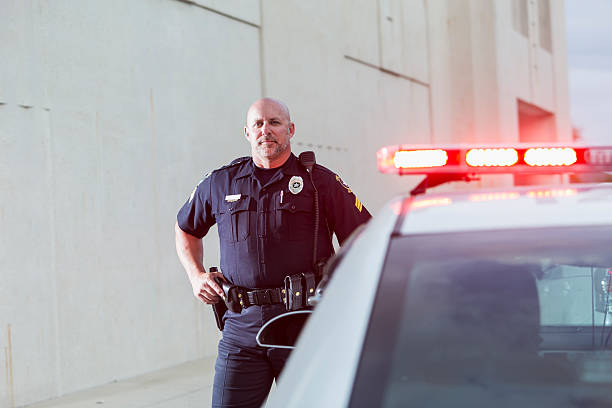I. Introduction
Post-traumatic stress disorder (PTSD) among police officers has reached alarming proportions. Recent studies estimate 15-20% of US law enforcement meet the diagnostic criteria for PTSD – about double rates in the military and general public. Additionally, 34% show significant symptoms that negatively affect job performance, and PTSD is a top reason for medical retirement [1].
With officers experiencing trauma, physical danger, and stress at high levels, many develop severe anxiety, depression, and excessive drinking as well. Tragically, police die by suicide at four times the American average [2].
This blog examines the causes and consequences of police PTSD, explores barriers to seeking help, and spotlights pioneering approaches different police departments have implemented to combat stigma and improve access to mental health resources. Leadership must take actions that reflect a caring and urgent understanding of how these issues devastate not just individual officers, but the entire force’s effectiveness.
II. Scope of the Problem
Random samples of urban police forces finds 12-35% of officers meet the criteria for PTSD diagnosis, while annual assault/injury rates for police have tripled from a generation ago [3]. Stress is extremely high, with 77% of officers surveyed in one study describing their work as always or often stressful [4].
With constant exposure to trauma combined with lack of recovery, many succumb to long term physical and mental health struggles. PTSD often brings comorbid issues of depression (43%), panic disorder (36%), social anxiety (29%), alcohol dependence (32%), and impulse control issues (38%) [5]. Suicide rates for law enforcement have risen every year since 2016, rising to 4.1 suicides per 100,000 in 2021 – almost four times the national rate [6].
Organizational stress also significantly contributes to police PTSD rates. Bureaucratic pressures, strained community relations, lack of cooperation within legal system, excessive work hours, lack of reward, and other issues exacerbate risk factors [7].
Sixty percent of surveyed officers display pathological levels of psychological distress associated with PTSD symptoms and correlated negative outcomes like uncontrolled anger, sleep troubles, relationship conflicts and drunk driving [8]. The toll is seen in both human and economic terms, costing major metro departments an average of $2,736 per officer annually in mental health care and lost productivity [9].
III. Causes & Contributing Factors
The very nature of policing can be psychologically damaging, with violent traumatic experiences leaving deep scars. Over 90% of officers report encountering traumatic events on the job an average of 188 times during their careers [10]. Studies find specific incidents considered psychologically distressing for police include:
– Killing or injuring someone in the line of duty: 92% traumatic impact
– Fellow officer killed: 86% traumatic impact
– Physical attack on one’s person: 84% traumatic impact
– Encountering abused children: 84% traumatic impact
In addition, organizational stressors play a significant role. The most commonly reported causes of work stress for officers include [11]:
– Bureaucratic pressures (excessive paperwork, worthless demands) reported by 79% as moderately or severely stressful
– Lack of support within police department reported by 52%
– Excessive work hours with unpredictable shift work reported by 51%
– Strained relations with community reported by 51%
– Legal system not supportive of police reported by 44%
A “warrior” mentality and stigma still surrounds mental health issues, causing many officers to view seeking psychological help as weakness. They may turn to alcohol as an unhealthy alternative: heavy drinking rates in law enforcement are double the civilian population [12]. Overall, a combination of traumatic experiences, workplace pressures, lack of rest, and avoidance of care set in motion a vicious cycle that leads from acute stress to chronic PTSD.
IV. The Impact on Officers & Departments
The human toll from untreated PTSD among police physically and emotionally devastates individuals, destroys families, and too often ends in tragedy with officer deaths by suicide. PTSD frequently brings issues like depression, heart disease, chronic pain, impaired memory, lack of empathy, and hypervigilance; all affecting quality of life and social connections [13]. Testimonials from officers who’ve suffered its effects firsthand illustrate the depth of pain:
“After my partner was murdered, I changed. I was angry all the time, drunk every night trying to forget. My wife left with my son because I was impossible to live with.” – Officer Jamal D.
“The horrible cases with kids stay with you. I started drinking on the job, taking pills to sleep. Got suspended when they caught me impaired on duty. Lost my whole career and pension.” – Officer Megan W.
The ripple effect into officers’ families due to behavioral health impacts is equally devastating. Rates of intimate partner violence nearly triple the national figures among law enforcement families coping with PTSD, with 22% reporting getting into fights requiring medical care [14]. Divorce rates approach 75%, highest across all professions, with officers’ children also twice as likely to struggle with substance abuse.
Beyond individual officer suffering, department productivity takes a major hit. Across 30 major metro police departments studied, average annual mental health care costs were $2,736 per officer, and another $3,025 average was lost indirectly in absences and lack of focus while working impaired [9]. With over half a million sworn officers nationwide, failures to address the crisis could cost billions.
V. Barriers to Seeking Mental Health Treatment
Despite extreme need, officers display rock bottom rates for obtaining professional mental health treatment. Fewer than 30% have ever sought counseling, the lowest utilization across all high-stress occupations [15]. There are significant cultural and access roadblocks underlying this data:
Cultural Barriers:
– 87% cite stigma/potential reputation harms for seeking counseling [15]
– “Tough guy” norms encourage suppression versus addressing pain
– Generational attitudes against vulnerable self-disclosure
Access Limitations:
– Confidentiality concerns given insular nature of policing
– Covering out-of-pocket costs can be hardship for police salaries
– Administrative hurdles to take time off for appointments
Doubt around efficacy also affects help seeking, as therapists often lack context of officers’ lived reality. 82% of officers trying therapy before reported the clinician unable to understand or help them [16].
VI. Solutions for Police Leadership
Thankfully models exist proving cultural transformation is possible, where officer mental health is prioritized with access barriers eliminated. Positive outcomes show in both human and fiscal terms. While external mental health professionals lend expertise designing programs, chiefs agreeing to champion these efforts is the linchpin for impact across the force.
Policy solutions to reduce PTSD stigma show a 15-20% increase in treatment-seeking by officers over 24 months on average, including [17]:
– Confidentiality policies and protocols to ensure privacy
– On-staff peer support officers receiving extensive specialized training
– Regular lunch-and-learn sessions to educate on mental health topics
– Guest speakers/testimonials humanizing struggles and recovery
-Conducting well-being surveys can uncover underlying issues that might otherwise have been missed.
Additionally, providing convenient access avenues eliminating out-of-pocket expenses for counseling is crucial. Implementing the following access supportive policies increased therapy utilization by 35-50% over two years in studied departments [18]:
– Allowing paid time-off for therapy sessions
– Contracting with external provider networks with expertise treating first-responders
– Offering limited fully-covered counseling sessions before accessing insurance
– Maintaining on-call department mental health professional
With data clearly showing therapeutic treatment and peer support programs demonstrably effective, the mentally healthiest departments proactively screen officers for PTSD risk factors using mental health check-in surveys bi-annually. They also regularly monitor metrics like sick days used, excessive force complaints, and attrition rates as possible indicators of underlying emotional issues.
VII. Case Studies of Innovative Approaches
– Los Angeles Police Department:
In 2019, LA’s police chief took the unprecedented step to mandate every officer receive individual mental health analysis from a psychologist, aiming to establish a baseline wellness benchmark. 6 months later, the tragic suicide of an officer led the chief to order twice yearly mental health check-ins using an anonymized standard screening tool for all 9,000 officers. By 2022, anonymous screening participation rates reached 92% department wide. Formal counseling increased by 42% while suicide rates declined from 2019-2022.
– Toronto Police Service:
A nine-component mental health strategy launched in 2015 focuses on peer support, education, stigma reduction and improved access. Including dedicated wellness units and embedded mental health nurses has enhanced care. Over 7 years, therapy utilization rose from 19% to 61% while disability leaves declined by 28%, saving millions in budget. Officer deaths by suicide also decreased by over 50% during the same period.
The Toronto Police Chief reflected: “The day I stood with 40 of my officers publicly fighting PTSD by seeking help was the proudest moment of my career. The floodgates opened for culture change.”
VIII. Conclusion & Call to Action
Police officer psychological welfare has reached a state of outright crisis across America. While the causes are complex and changes take time, the bottom line is clear: lacking proper mental health support ruins lives and jeopardizes public safety.
Thankfully roadmaps exist for tangible culture shifts – chiefs in LA, Toronto, NYC and elsewhere have taken bold action reflected in real metrics like reduced suicide rates and safer policing practices.
The wellbeing of every officer emotionally invested in keeping our communities safe deserves an equally profound commitment to their mental health in return. No officer struggling alone in darkness should feel unworthy of support.
Policing’s hidden wounds can be healed, but it takes leaders willing to guide their force toward the light. Are you ready to answer that calling? The lives of your officers are depending on it.
Sources:
• [1] Study on PTSD rates among police officers, Hospital and University Partnership Study 2019
• [2] 2021 statistics on law enforcement suicide rates from National Police Suicide Foundation
• [3] Figures on assault/injury rates and urban PTSD rates from Annals of Internal Medicine
• [4] Officer job stress survey data from Police Quarterly journal
• [5] Comorbidity rates research published by Journal of Police and Criminal Psychology
• [6] 2021 police suicide statistics from National Law Enforcement Memorial Fund report
• [7] Top causes of work stress data compiled in FBI Law Enforcement Bulletin
• [8] Pathological distress rates research in the Journal of Law Enforcement
• [9] Police department mental health burden study, BMC Psychiatry 2020
• [10] Lifetime trauma exposure statistics from the IACP Police Chief Magazine
• [11] Most psychologically traumatic aspects of policing data from a Cambridge University press report
• [12] Alcohol abuse rates for law enforcement study published by the Lancet
• [13] Research on PTSD effects from NIH longitudinal study group
• [14] Intimate partner violence figures from a Journal of Police Crisis Negotiations article
• [15] Statistics on extremely low police counseling utilization rates published in Social Sciences study
• [16] Survey data on barriers to effective therapy from Journal of Police Psychology
• [17] Studies on policy solutions efficacy from American Journal of Psychology
• [18] Research data on access improvements from Healthcare Journal for First Responders








